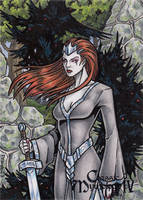Perna Studios is very excited to announce our 19th trading card set entitled Classic Mythology IV: World Mythology. This set will focus on Gods, Goddesses and Creatures from the following mythologies; Greek, Egyptian, Norse, Celtic, Japanese, Chinese, Native American, Aztec/Mayan, Inuit, Hindu and African. We have an impressive list of artists involved on this set working on both base/promo cards and sketch cards. Classic Mythology IV trading card set was released in early Summer 2023.
I drew this sketch card of the Morrigan from Celtic mythology for the Classic Mythology IV trading card set.
The Morrigan (also known as the Morrigu) was the shape-shifting Celtic Goddess of War, Fate and Death. She also presided over rivers, lakes and fresh water, in addition to being the patroness of revenge, night, magic, prophecy, priestesses and witches. Her name is interpreted in various forms..."Great Queen,""Phantom Queen" or "Queen of Demons." She was said to hover over battlefields in the form of a raven or hooded crow and frequently foretold or influenced the outcome of the fray. The Morrigan was often depicted as a triune goddess whose other aspects were manifested in the Goddess Badb (meaning "Vulture" or "Venomous") and the Goddess Nemain (meaning "Frenzy" or "Fury"). The Morrigan was one of the Tuatha De Danaan ("People of the Goddess Danu") and she aided in the defeat of the Firbolgs at the First Battle of Magh Tuireadh and the Fomorii at the Second Battle of Mag Tured. The Celts believed that, as they engaged in warfare, the Morrigan flew shrieking overhead in the form of a raven or carrion crow, summoning a host of slain soldiers to a macabre spectral bane. When the battle had ended, the warriors would leave the field until dawn in order that the Morrigan could claim the trophies of heads, euphemistically known as "the Morrigan's acorn crop." The origins of the Morrigan appear to be directly linked to the megalithic Cult of the Mothers, who usually appeared as triple goddesses. Her role in Celtic legend is similar to that of the Valkyries in Norse folklore in that both used magic to cast fetters on warriors and made the decision regarding who would live and who would die. The Morrigan is also closely associated with horse symbolism and may, on occasion, have been linked with the equine Goddess, Epona. Another guise of the Morrigan is that of the "Washer at the Ford," who could usually be found washing the clothes of men about to die in battle. In effect, she is thus choosing those whose lives will be lost in the upcoming conflict. An old English poem entitled "Exodus" also refers to ravens (as previously mentioned, one of the Morrigan's other chosen manifestations) as choosers of the slain.
www.deviantart.com/pernastudio…
![thumbnail]()
I drew this sketch card of the Morrigan from Celtic mythology for the Classic Mythology IV trading card set.
The Morrigan (also known as the Morrigu) was the shape-shifting Celtic Goddess of War, Fate and Death. She also presided over rivers, lakes and fresh water, in addition to being the patroness of revenge, night, magic, prophecy, priestesses and witches. Her name is interpreted in various forms..."Great Queen,""Phantom Queen" or "Queen of Demons." She was said to hover over battlefields in the form of a raven or hooded crow and frequently foretold or influenced the outcome of the fray. The Morrigan was often depicted as a triune goddess whose other aspects were manifested in the Goddess Badb (meaning "Vulture" or "Venomous") and the Goddess Nemain (meaning "Frenzy" or "Fury"). The Morrigan was one of the Tuatha De Danaan ("People of the Goddess Danu") and she aided in the defeat of the Firbolgs at the First Battle of Magh Tuireadh and the Fomorii at the Second Battle of Mag Tured. The Celts believed that, as they engaged in warfare, the Morrigan flew shrieking overhead in the form of a raven or carrion crow, summoning a host of slain soldiers to a macabre spectral bane. When the battle had ended, the warriors would leave the field until dawn in order that the Morrigan could claim the trophies of heads, euphemistically known as "the Morrigan's acorn crop." The origins of the Morrigan appear to be directly linked to the megalithic Cult of the Mothers, who usually appeared as triple goddesses. Her role in Celtic legend is similar to that of the Valkyries in Norse folklore in that both used magic to cast fetters on warriors and made the decision regarding who would live and who would die. The Morrigan is also closely associated with horse symbolism and may, on occasion, have been linked with the equine Goddess, Epona. Another guise of the Morrigan is that of the "Washer at the Ford," who could usually be found washing the clothes of men about to die in battle. In effect, she is thus choosing those whose lives will be lost in the upcoming conflict. An old English poem entitled "Exodus" also refers to ravens (as previously mentioned, one of the Morrigan's other chosen manifestations) as choosers of the slain.
www.deviantart.com/pernastudio…
